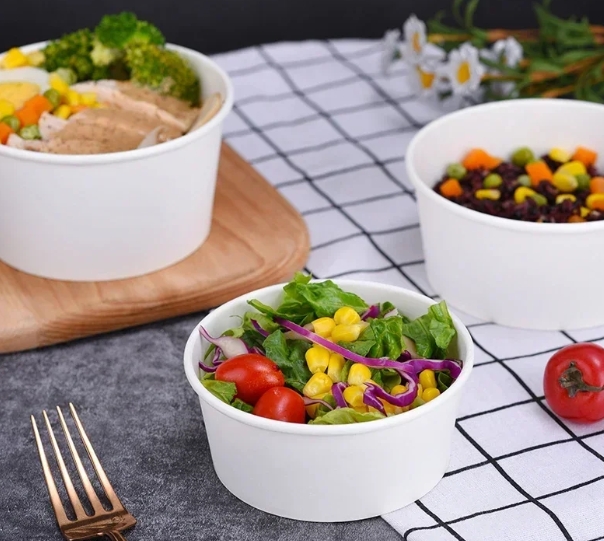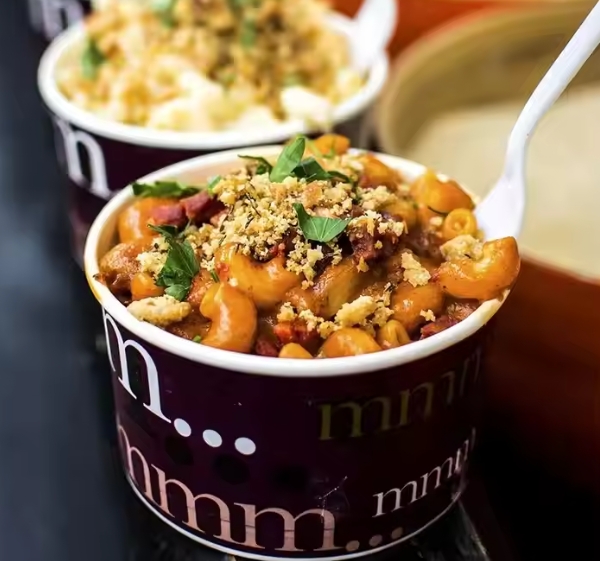
Content Menu
● What Are Disposable Food Bowls?
>> Types of Disposable Food Bowls
● How Disposable Food Bowls Make Clean-up Easier
>> 1. Elimination of Washing Dishes
>> 2. Convenience and Portability
>> 3. Hygiene and Safety
>> 4. Time and Labor Saving
>> 5. Versatility
>> 6. Reducing Clutter and Space Usage
● Environmental Considerations
>> Eco-Friendly Options
>> Challenges and Solutions
● Practical Uses of Disposable Food Bowls
>> Events and Catering
>> Food Delivery and Takeout
>> Home Use
>> Commercial Food Service
>> Schools and Hospitals
● Additional Benefits of Disposable Food Bowls
>> Customization and Branding
>> Cost-Effectiveness
>> Safety in Outdoor and Emergency Situations
● How to Choose the Right Disposable Food Bowl
● Maintenance and Disposal Tips
● Conclusion
● FAQ
>> 1. What materials are disposable food bowls made from?
>> 2. Are disposable food bowls environmentally friendly?
>> 3. Can disposable food bowls be used for hot foods?
>> 4. How do disposable food bowls improve hygiene?
>> 5. Are disposable food bowls recyclable?
● Citations:
In today's fast-paced world, convenience and efficiency are paramount, especially when it comes to food service and clean-up. Disposable food bowls have become an essential item for many households, restaurants, and event organizers. This article explores how disposable food bowls simplify clean-up, their types, benefits, environmental impact, and practical uses, supported by detailed explanations and examples to enhance understanding.

What Are Disposable Food Bowls?
Disposable food bowls are single-use containers designed to hold various types of food. They are typically made from materials such as plastic, paper, biodegradable substances like cornstarch or sugarcane, and polypropylene (PP) plastic. These bowls are widely used in catering, fast food, picnics, and home settings due to their convenience and hygiene benefits.
Types of Disposable Food Bowls
- Plastic Disposable Bowls: Lightweight and often come with lids, ideal for salads, soups, and other dishes that require freshness and spill prevention. Plastic bowls are usually made from materials like PET or PP, which offer durability and clarity.
- Paper Disposable Bowls: Eco-friendly and suitable for dry or semi-dry foods. These bowls are often coated with a thin layer of wax or PLA (polylactic acid) to provide moisture resistance.
- Biodegradable Bowls: Made from natural materials like cornstarch, sugarcane bagasse, or wheat bran, these bowls decompose naturally, reducing environmental impact. They are increasingly popular as sustainable alternatives.
- PP Plastic Bowls: Durable, heat-resistant, and bactericidal, suitable for hot and cold foods. PP bowls can withstand microwaving and are often used in food delivery services.
Disposable food bowls come in various sizes and shapes, from small dessert bowls to large soup containers, catering to diverse culinary needs.
How Disposable Food Bowls Make Clean-up Easier
1. Elimination of Washing Dishes
One of the most significant advantages of disposable food bowls is that they eliminate the need for washing dishes after meals. This saves time and effort, especially during large gatherings or busy food service operations. Instead of spending time scrubbing and soaking, users can simply discard the bowls, making clean-up almost instantaneous.
2. Convenience and Portability
Disposable bowls are lightweight and easy to transport, making them perfect for picnics, office lunches, and outdoor events. Many come with secure lids to prevent spills during transport, which is especially useful for liquid or semi-liquid foods like soups and stews. This portability reduces the risk of messes and makes eating on the go hassle-free.
3. Hygiene and Safety
Since disposable bowls are single-use, they reduce the risk of cross-contamination and foodborne illnesses. This is particularly important in hospitals, schools, and catering services where hygiene is critical. Using disposable food bowls ensures that each person has a clean, uncontaminated container, which is vital in preventing the spread of germs.
4. Time and Labor Saving
Using disposable bowls reduces the labor involved in cleaning up, allowing staff or hosts to focus on other tasks or enjoy their time with guests. In commercial settings, this can translate into significant cost savings by reducing the need for dishwashing staff and equipment maintenance.
5. Versatility
Disposable food bowls are suitable for a wide range of foods, including soups, salads, rice dishes, and desserts. Their thermal insulation properties help maintain food temperature, enhancing the eating experience. Some disposable bowls are designed with compartments or special coatings to handle oily or acidic foods without leaking or degrading.
6. Reducing Clutter and Space Usage
In environments where space is limited, such as food trucks, small kitchens, or outdoor events, disposable food bowls help reduce clutter. Since they are discarded after use, there is no need for storage space for dirty dishes, which can accumulate quickly and create mess.
Environmental Considerations
While disposable food bowls offer convenience, their environmental impact is a concern. Traditional plastic bowls can take decades to decompose, contributing to pollution and landfill overflow. However, the rise of biodegradable and compostable bowls made from cornstarch, sugarcane, and other natural materials offers a sustainable alternative.
Eco-Friendly Options
- Biodegradable Bowls: These break down naturally in composting facilities, reducing landfill waste. They are made from renewable resources and do not release harmful chemicals during decomposition.
- Compostable Bowls: Convert into nutrient-rich soil, supporting circular economy principles. Compostable bowls are certified to break down within a specific timeframe under industrial composting conditions.
- Recyclable Plastic Bowls: Some PP plastic bowls can be recycled, minimizing environmental footprint. However, recycling rates depend heavily on local infrastructure and consumer participation.
Challenges and Solutions
Despite the availability of eco-friendly disposable food bowls, challenges remain:
- Contamination: Food residue can contaminate recycling streams, making it difficult to recycle disposable bowls effectively.
- Composting Infrastructure: Not all regions have access to industrial composting facilities, limiting the effectiveness of compostable bowls.
- Consumer Awareness: Proper disposal methods are essential to maximize environmental benefits, requiring education and clear labeling.
Manufacturers and policymakers are working to improve materials, increase recycling rates, and expand composting infrastructure to address these challenges.

Practical Uses of Disposable Food Bowls
Events and Catering
Disposable food bowls are widely used in catering for weddings, parties, and corporate events. They simplify serving and clean-up, allowing hosts to focus on guest experience. For example, at large outdoor weddings, disposable bowls enable quick distribution of food and easy disposal afterward, eliminating the need for bulky dishwashing setups.
Food Delivery and Takeout
Restaurants and food delivery services use disposable bowls to package meals securely, ensuring food stays fresh and is easy to consume on the go. Many bowls come with tight-fitting lids to prevent leaks during transport, which is crucial for maintaining food quality and customer satisfaction.
Home Use
For busy families or individuals, disposable bowls offer a quick solution for meals without the hassle of washing up, especially during gatherings or outdoor activities. They are also popular for meal prepping and portion control, allowing users to prepare meals in advance and store them conveniently.
Commercial Food Service
Fast food outlets and cafeterias benefit from disposable bowls for their efficiency, hygiene, and ease of disposal. They help streamline operations by reducing the need for dishwashing and minimizing wait times for clean dishes.
Schools and Hospitals
In institutions like schools and hospitals, disposable food bowls help maintain strict hygiene standards. They prevent cross-contamination and reduce the risk of infection, which is critical in these sensitive environments.
Additional Benefits of Disposable Food Bowls
Customization and Branding
Disposable food bowls can be customized with logos, colors, and designs, making them a valuable marketing tool for businesses. Restaurants and catering companies often use branded disposable bowls to enhance brand recognition and create a professional appearance.
Cost-Effectiveness
While reusable bowls may seem economical over time, the costs associated with water, detergent, labor, and equipment maintenance can add up. Disposable food bowls offer a cost-effective alternative, especially when factoring in labor savings and reduced utility expenses.
Safety in Outdoor and Emergency Situations
Disposable food bowls are ideal for outdoor activities such as camping, hiking, and festivals, where access to clean water and dishwashing facilities is limited. They are also essential in emergency relief efforts, providing safe and hygienic food containers in disaster zones.
How to Choose the Right Disposable Food Bowl
Selecting the appropriate disposable food bowl depends on several factors:
- Type of Food: Hot soups require heat-resistant bowls, while salads may be better suited to clear plastic or paper bowls.
- Environmental Impact: Consider biodegradable or compostable options if sustainability is a priority.
- Portability: Bowls with secure lids are essential for takeout and delivery.
- Size and Portion: Choose sizes that match portion requirements to minimize waste.
- Budget: Balance cost with quality and environmental considerations.
By carefully evaluating these factors, consumers and businesses can optimize their use of disposable food bowls for convenience and sustainability.
Maintenance and Disposal Tips
To maximize the benefits of disposable food bowls and minimize environmental impact, consider the following tips:
- Separate Waste: Dispose of biodegradable bowls in compost bins and recyclable plastic bowls in recycling bins.
- Avoid Contamination: Rinse bowls lightly if possible before recycling to reduce food residue contamination.
- Educate Users: Provide clear instructions on disposal methods to ensure proper waste management.
- Support Sustainable Brands: Choose suppliers committed to eco-friendly practices and certifications.
Conclusion
Disposable food bowls significantly ease the clean-up process by eliminating the need for washing dishes, saving time and labor, and enhancing hygiene. Their convenience and versatility make them ideal for various settings, from casual picnics to large-scale catering events. While traditional plastic bowls pose environmental challenges, the development of biodegradable and compostable options offers a sustainable path forward. Choosing the right disposable food bowl can balance convenience with environmental responsibility, making clean-up easier without compromising on eco-consciousness. As awareness and technology improve, disposable food bowls will continue to evolve, providing even more efficient and sustainable solutions for food service and clean-up.

FAQ
1. What materials are disposable food bowls made from?
Disposable food bowls are commonly made from plastic, paper, biodegradable materials like cornstarch or sugarcane, and polypropylene (PP) plastic.
2. Are disposable food bowls environmentally friendly?
Traditional plastic bowls are not environmentally friendly due to slow decomposition, but biodegradable and compostable bowls offer eco-friendly alternatives that break down naturally.
3. Can disposable food bowls be used for hot foods?
Yes, many disposable bowls, especially those made from PP plastic or biodegradable materials, are heat-resistant and suitable for hot soups and meals.
4. How do disposable food bowls improve hygiene?
Since they are single-use, disposable bowls reduce the risk of cross-contamination and foodborne illnesses, making them ideal for hospitals, schools, and catering.
5. Are disposable food bowls recyclable?
Some disposable bowls, particularly those made from PP plastic, can be recycled, but it depends on local recycling facilities. Biodegradable bowls are compostable rather than recyclable.
Citations:
[1] https://www.sweetflavorfl.com/blog/everything-you-need-to-know-about-disposable-salad-bowls-n14
[2] https://www.tradeindia.com/question-answer/what-are-the-advantages-of-disposable-bowl/
[3] https://www.dayuplastic.com/news/industry-news/the-advantages-and-challenges-of-disposable-pp-plastic-bowls.html
[4] https://www.istockphoto.com/photos/disposable-bowl
[5] https://www.vecteezy.com/free-photos/disposable-food-packaging
[6] https://www.craftecopack.com/blog/6-best-disposable-bowls-for-hot-soup-everything-you-need-to-know_b26
[7] https://emeraldecovations.com/2024/09/the-convenience-and-sustainability-of-disposable-bowls/
[8] https://www.hydepackage.com/info-detail/advantages-of-using-disposable-cornstarch-bowls
[9] https://www.istockphoto.com/photos/disposable-bowls
[10] https://www.freepik.com/free-photos-vectors/disposable-bowls
[11] https://www.vecteezy.com/free-photos/paper-bowl
[12] https://reliancepak.com/blog/blog_1114-6/
[13] https://www.cleaninginstitute.org/cleaning-tips/dishes/wash-dishwasher-or-hand/plastic-food-containers-and-dishes
[14] https://reliancepak.com/blog/blog_1120-2/
[15] https://kitchendance.com/blogs/default-blog/blog-benefits-of-using-disposable-food-containers
[16] https://www.packagingbag5.com/news/what-are-the-advantages-and-disadvantages-of-d-76038630.html
[17] https://www.shutterstock.com/search/disposable-paper-bowl
[18] https://www.freepik.com/free-photos-vectors/disposable-bowl
[19] https://www.youtube.com/watch?v=y2lPR2QT5EI
[20] https://www.youtube.com/watch?v=VDcDYKLIces
[21] https://www.elfac.org/5-ways-to-make-dinnertime-cleanup-easier/
[22] https://www.jc-foodpack.com/list/6-benefits-of-disposable-food-containers.htm
[23] https://www.freepik.com/free-photos-vectors/plastic-bowl
[24] https://www.youtube.com/watch?v=U6eAvrg4f_U
[25] https://www.youtube.com/watch?v=RQKei50JCNQ

















